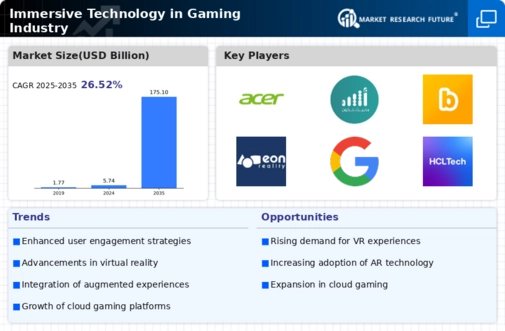Market Trends
Key Emerging Trends in the Immersive Technology in Gaming Industry Market
Gaming industry has witnessed a surge in the adoption of immersive technologies, transforming the way players interact with games and experiences. Immersive technology refers to technologies that create a sense of presence and immersion by engaging multiple senses, such as virtual reality (VR), augmented reality (AR), and mixed reality (MR). One prominent trend in this market is the increasing popularity of VR gaming, driven by advancements in VR hardware, software, and content. VR gaming provides players with immersive and interactive experiences, allowing them to step into virtual worlds and interact with environments and characters in new and exciting ways. With the introduction of standalone VR headsets such as the Oculus Quest and PlayStation VR, VR gaming has become more accessible and affordable, attracting a broader audience of gamers.
Another notable trend is the integration of AR technology into mobile gaming experiences, enabling players to overlay digital content and interactive elements onto the real world through their smartphones or tablets. AR gaming apps such as Pokémon GO and Harry Potter: Wizards Unite have gained widespread popularity, blending virtual elements with the physical environment to create engaging and interactive gameplay experiences. AR technology also offers opportunities for location-based gaming, multiplayer experiences, and social interaction, enabling players to explore and interact with the world around them in new and innovative ways.
Furthermore, there is a growing interest in mixed reality (MR) gaming, which combines elements of both VR and AR to create immersive and interactive experiences that seamlessly blend virtual and real-world elements. MR gaming headsets such as Microsoft's HoloLens and Magic Leap One offer players the ability to interact with holographic objects and digital content overlaid onto their physical surroundings, creating a truly immersive and interactive gaming experience. MR gaming has applications beyond traditional gaming, including education, training, and enterprise use cases, enabling users to visualize and interact with complex data, simulations, and 3D models in real-time.
Additionally, the rise of cloud gaming services is reshaping the gaming landscape and driving the adoption of immersive technologies. Cloud gaming platforms such as Google Stadia, NVIDIA GeForce Now, and Xbox Cloud Gaming (formerly known as Project xCloud) enable players to stream games over the internet to a variety of devices, including smartphones, tablets, smart TVs, and PCs, without the need for high-end gaming hardware. These platforms leverage cloud computing and streaming technologies to deliver high-quality gaming experiences with minimal latency, enabling players to access and play immersive games anytime, anywhere, on any device.
Moreover, the convergence of gaming and entertainment industries is fueling the adoption of immersive technologies in gaming. With the rise of virtual concerts, live events, and social experiences in virtual worlds such as Fortnite and Roblox, immersive technologies are increasingly being used to create interactive and engaging entertainment experiences that transcend traditional gaming boundaries. Virtual reality concerts, immersive theater experiences, and virtual theme parks are just a few examples of how immersive technologies are transforming the entertainment landscape and blurring the lines between gaming, entertainment, and social interaction.
Lastly, the COVID-19 pandemic has accelerated the adoption of immersive technologies in gaming, as people seek alternative forms of entertainment and social interaction while staying at home. With lockdowns, social distancing measures, and restrictions on public gatherings in place, virtual reality, augmented reality, and mixed reality technologies have emerged as viable solutions for connecting people, providing entertainment, and fostering social interaction in a virtual environment. As a result, the demand for immersive gaming experiences has surged, driving investments in VR hardware, software development, and content creation, and paving the way for the continued growth and expansion of immersive technologies in the gaming market.













Leave a Comment